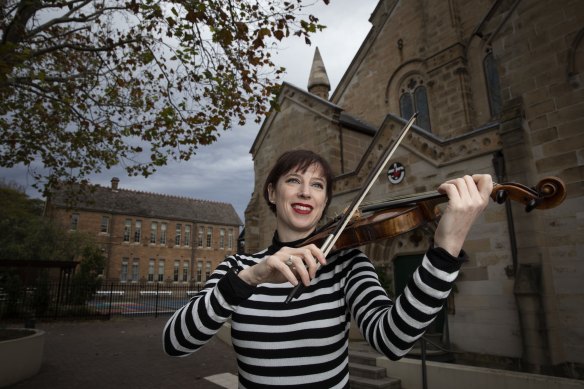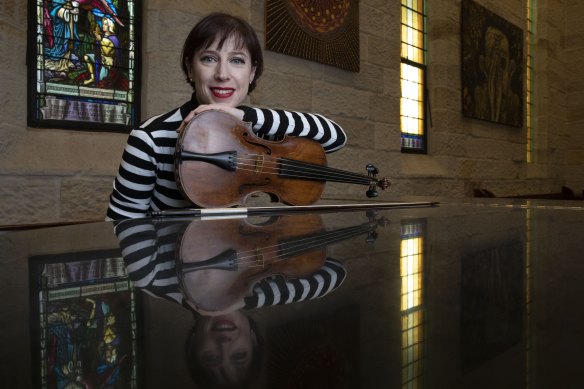Save articles for later
Add articles to your saved list and come back to them any time.
Madeleine Easton arrives at a Rozelle cafe on a bright Autumn day with her dog, Rosie, in tow. The Sydney-based violinist only arrived home from a European tour two days ago, but she has already been up for hours – a morning run, a student to teach, and the first of many hours of practice for the day.
For much of the last two decades, Easton has been based in the UK, where a busy career as a violinist, concertmaster and director has seen her play for leading ensembles including the London Philharmonic Orchestra, the City of Birmingham Symphony, Orchestra of the Age of Enlightenment, the Academy of Ancient Music, and the Orchestra Revolutionaire et Romantique.
Madeleine Easton has performed in some of the best orchestras in the world.Credit: Jessica Hromas
More recently life and family has brought her back to Sydney, but it has not curtailed her musical ambition: in 2016 she founded the Bach Akademie Australia, an ensemble devoted to the music of Johann Sebastian Bach. It is the latest in a swathe of specialist period instrument orchestras that have sprung up over the last 20 years and its focus is unapologetically narrow.
“When I first had the idea to form a dedicated Bach orchestra in Australia I had equal amounts of people telling me it would never work and equal amounts of people telling me, ‘Yes, this is exactly what we need,’” says Easton. “Now here we are, going great guns. It’s working. I knew it. I knew there was a market for this.”
Easton’s fiery determination is fuelled by her association, over the last two decades, with Sir John Eliot Gardiner, founder of the English Baroque Soloists. The baroque music legend is a mentor to the Australian violinist and patron of Bach Akademie Australia.
Easton’s recent trip to Europe was for a tour celebrating Gardiner’s 80th birthday, performing Bach’s B Minor Mass in Versailles, Barcelona, Hamburg, Brussels, Luxembourg and Frankfurt, and in London’s St-Martin-in-the-Fields. The tour culminated in a once-in-a-lifetime concert at Westminster Abbey as part of the coronation of King Charles III.
Easton is no stranger to playing for royalty. The English Baroque Soloists are one of the King’s favourite ensembles, and she has performed at Westminster Abbey and even Buckingham Palace on many occasions. She has met Queen Camilla – “she’s fabulous,” the violinist says– and she describes King Charles III as a fine cellist.
But while the coronation, with all its pomp and glamour, was unforgettable, the highlight, for her, was two days earlier.
The orchestra were rehearsing for their part in service, which was to give a mini-concert for the assembled guests as they waited for the King and Queen to make their way from Buckingham Palace to the Abbey in their horse-drawn golden carriage. Not wanting to miss the concert, Charles decided to attend the rehearsal.
Easton beams at the memory. “We rehearsed for a full hour,” she says. “He stayed for the whole time and at the end he had tears coming down his face. At the end he got up and said, ‘Thank you, it was the greatest privilege to hear you play.’”
Easton performed at King Charles III’s coronation in May, with the English Baroque Soloists.Credit: Jessica Hromas
Back in Sydney, Easton’s next big challenge is more intimate but no less epic, as she performs Bach’s six Sonatas and Partitas for Solo Violin over four days. These extraordinary works are considered the cornerstone of any classical violinist’s repertoire: virtually every virtuoso from Yehudi Menuhin to Richard Tognetti has recorded them. They have been compared to the great soliloquies of Shakespeare.
What is it about the Solo Sonatas and Partitas that makes them such a landmark work?
“In each of these sonatas and partitas you will find the greatest joy and the most profound sadness and the most wonderful peaceful stillness,” explains Easton. “The joy and the tragedy and the expansiveness and everything we go through as human beings… It takes you to the highest highs, and leaves you feeling utterly glad.”
They are also very difficult: a violinist must play all four strings simultaneously.
“For him to do that on a violin is just beyond the realms of comprehension,” says Easton. “You have to twist your hands into all sorts of nasty positions, and all the while phrasing and thinking about the direction of the melody, the direction of the piece, balancing the four voices out.”
But the challenge is worth it, says Easton. “They are staggering in their inventiveness. They represent such a pinnacle of composition, in terms of what is possible on a solo violin. They’re some of the most beautiful pieces of music every written.
“This is what separates him from all his contemporaries. No other composer can do that to you. Bach does. This is why I started the orchestra.”
The Solo Sonatas and Partitas is at Paddington Uniting Church, June 15-17, and Our Lady of Dolours, Chatswood, June 18.
Sydney Morning Herald subscribers can enjoy 2-for-1 tickets* to the Archibald, Wynne and Sulman Prizes exhibition at the Art Gallery of New South Wales during June 2023. Click here for more details.
Find out the next TV, streaming series and movies to add to your must-sees. Get The Watchlist delivered every Thursday.
Most Viewed in Culture
From our partners
Source: Read Full Article




